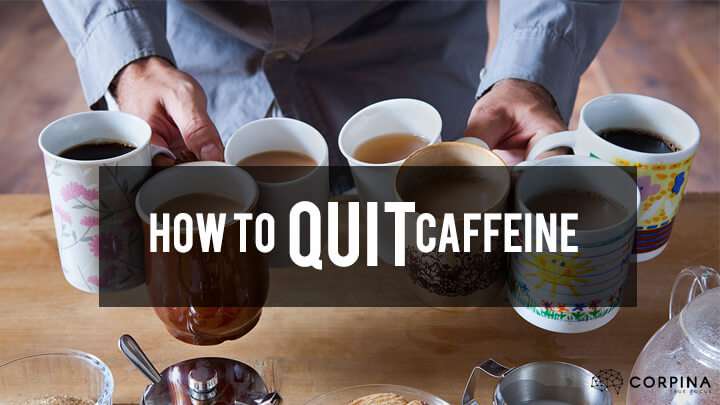How To Quit Caffeine Without Painful Withdrawals
Caffeine is a bitter elixir known to the world over for enhancing focus, attention, and improving mood. Those who are sensitive to caffeine even experience euphoria when consuming their first cup and it is no wonder coffee is the second most popular drink in the world after water.
Beyond the good feelings, caffeine can help burn fat, reduce appetite, and increase blood flow throughout the body.
But sometimes, just like any other tool, caffeine can be abused. The side effects of caffeine consumption (especially consistently) include anxiety, blood pressure, and heart rate to name a few. Beyond that, there is general fatigue, which can be exacerbated by hormone altering caffeine.
My body has felt compromised for the past week and my immune system weakened for many months. This is a great reason to quit caffeine, but occasionally it is good to cycle even if your body isn’t compromised. By resetting your tolerance, you can make the drug even more effective with less dosage than before.
Weaning off Caffeine
Some people are masochists and enjoy the pain of cold turkey. This is possible, but it may be better to wean yourself off of caffeine gradually. The weaning process can be as difficult or simple as you desire.
When I was drinking cold brew coffee in the morning, I was consuming in the range of 175 – 200 mg per dose. That is much less than the 3 – 4 cups of coffee per day, which total 5 – 600 mg in total. The higher doses will be the hardest to quit cold turkey.
Anyone who has professional responsibilities might find the whole process debilitating. Taking smaller doses over the course of a few days is an easy answer for this problem.
I went from taking 175 – 200 mg per day down to 80 mg doses for two days. I used caffeine pills so I could measure it out properly and I paired it with 160 of L-theanine, which helps negate many of the side effects of caffeine.
This process might look different depending on your particular situation. If you have a much stronger addiction to caffeine, you may consider drinking fewer cups a day and then smaller doses.
Replacing Caffeine
Replacing caffeine is difficult because there are few compounds that have the same efficacy for focus, attention, and mood. There are even fewer that are well-studied as is caffeine.
Sometimes replacing caffeine with another addiction is of no use, however. There are two paths to follow in the caffeine replacement phase and hopefully you will choose the right one for your needs.
There are two paths:
- Stimulant replacement – caffeine is a powerful stimulant and if you need this to do your work, a replacement might be in order. You could look into experimental drugs and high-powered prescriptions that are currently used as stimulants. These include things like modafinil or phenylpiracetam, which is a stimulant in the racetam family.
- Natural stress-relief – Most people who decide to quit caffeine are doing so in order to remove the burden of stress from the body. There are several natural or mild / well-researched options that can help you to detox without leading to withdrawal symptoms or addiction to some other substance.
Here are some of the stress-relieving nootropics that I believe you can use to maintain cognitive function even while detoxing:
- Rhodiola rosea – Used by the Vikings before battle, rhodiola rosea is an adaptogenic herb. This means it can help the body to adapt to stressors (such as not having caffeine) and can allow it to perform better. Rhodiola has a host of other benefits as well including reduced feelings of fatigue and cognitive performance. Other herbs that are considered adaptogens include panax ginseng, holy basil, ashwagandha, and cordyceps mushroom.
- L-Tyrosine – This non-essential amino acid is particularly useful for increasing one’s ability to handle stress. Most research on the drug shows that it is an option to enhance dopamine in the brain and maintain cognitive function during bouts of stress. Anyone who has cycled off of caffeine will attest that it can be a source of stress!
- Aniracetam / Oxiracetam – Both aniracetam and oxiracetam are drugs within the racetam family that have a couple of decades worth of research. While they are both synthetic derivatives of GABA, aniracetam is a highly stimulating nootropic. Oxiracetam is known to be stimulating as well as neuroprotective.
My personal stack has gone something like this:
- 1000 mg L-tyrosine 2 – 3 hours after waking
- 750 mg Aniracetam / Oxiracetam 6 hours after waking (with food)
No More Replacements
After you have used the above nootropics for a few days (some might need a week), it may be helpful to remove the replacement drugs from your regimen so you can experience the caffeine detox without any other psychoactive ingredient.
Your key objective may be to remove the need for caffeine, but it’s healthier to avoid adding an addiction in its place. The first two steps of the process include weaning and replacing caffeine, which will allow you to reduce your tolerance and experience the benefits of caffeine again.
The final step, removing all replacements, will allow you to detoxify from needing any of these stimulants in order to function mentally.
[catlist excludeposts=this template="div" conditional_title_tag="h6" conditional_title="More on Caffeine" id="82" tags="using"] [catlist excludeposts=this template="div" conditional_title_tag="h6" conditional_title="Supplements for energy" tags="for-energy" exclude_tags="getting-high"]

